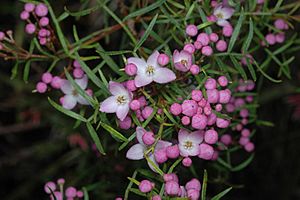Bronzy boronia facts for kids
Quick facts for kids Bronzy boronia |
|
|---|---|
 |
|
| Boronia thujona in the Australian National Botanic Gardens | |
| Scientific classification | |
 |
|
| Occurrence data from Australasian Virtual Herbarium |
The Bronzy Boronia (scientific name: Boronia thujona) is a special plant. It belongs to the citrus family, called Rutaceae. You can only find it in certain coastal parts of southern New South Wales, Australia. This plant can be a shrub or a small tree. It has leaves that smell nice and are shaped like feathers (this is called pinnate). It also grows pretty bright pink flowers, usually in groups of two to six, right where the leaves meet the stem (this spot is called the leaf axil).
What it Looks Like
The Bronzy Boronia is a smooth plant (meaning it's glabrous, or hairless). It can grow as a shrub or a small tree, reaching a height of about 1–4 m (3–10 ft). Its smaller stems have two grooves near where the leaves attach.
Its leaves are very fragrant and are made up of many smaller leaflets, usually between three and fifteen of them. The whole leaf is about 30–80 mm (1–3 in) long and 23–70 mm (0.9–3 in) wide. The stalk that connects the leaf to the stem (called a petiole) is about 10–15 mm (0.4–0.6 in) long.
The leaflet at the very end of the leaf is shaped like a narrow oval. It measures about 5–25 mm (0.2–1 in) long and 1–4 mm (0.04–0.2 in) wide. The leaflets on the sides are similar but often a bit longer.
The flowers are a bright pink color. They grow in pairs or in groups of up to six in the leaf axils. Each flower has its own small stalk, called a pedicel, which is about 5–15 mm (0.2–0.6 in) long.
Each flower has four small, triangular sepals, which are like tiny leaves that protect the flower bud. These are about 0.5–1.5 mm (0.02–0.06 in) long and 0.5–1 mm (0.02–0.04 in) wide. There are also four petals, which are the colorful parts of the flower. They are about 5–10 mm (0.2–0.4 in) long and have a slightly hairy underside. Each petal has a tiny point at its tip.
Inside the flower, there are eight stamens, which are the parts that produce pollen. Their stalks (called filaments) are hairy. The part of the flower that receives pollen, called the stigma, is about the same width as the style (the stalk connecting the stigma to the ovary).
Bronzy Boronia flowers bloom from August to November. After flowering, the plant produces a smooth, dry fruit called a capsule. This capsule is about 3–4 mm (0.12–0.16 in) long and 2–2.5 mm (0.08–0.1 in) wide.
How it Got its Name
Scientific Naming
The scientific name, Boronia thujona, was first officially described in 1922. This was done by two scientists, Arthur de Ramon Penfold and Marcus Baldwin Welch. Their description was published in a scientific journal called Journal and proceedings of the Royal Society of New South Wales.
The second part of the name, thujona (which is called the specific epithet), comes from a chemical compound called thujone. Arthur Penfold was a chemist, and Marcus Welch was an economic botanist. They were able to extract this chemical from the plant.
Common Name
The common name, "bronzy boronia," was first used by a person named Jean Galbraith in 1977. This name refers to a slight bronze shine that you can sometimes see on the plant's leaves.
Where it Lives
The Bronzy Boronia likes to grow in damp, shady forests. You can find it in the Sydney area and further south, all the way to the Budawang Range in New South Wales.

